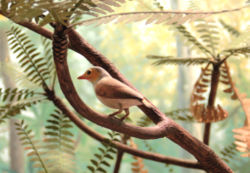Contents |
Aves incertae sedis
- †Holbotia (Early Cretaceous of Andaikhudag, Mongolia) - basal pygostylian?
- †Hongshanornis (Yixian Early Cretaceous of China) - pygostylian?
- †Nanantius (Early Cretaceous) - enantiornithine
- †Otogornis (Yijinhuoluo Early Cretaceous of Yike Zhaomeng, China) - basal pygostylian? enantiornithine?
- †Protopteryx (Early Cretaceous of China) - enantiornithine?
- †Wyleyia (Early Cretaceous) - enantiornithine? neornithine (paleognath)?
- †Asiahesperornis (Late Cretaceous of Eginsai, Kazakhstan) - hesperornithiform?
- †Euornithes gen. et sp. indet. (Bissekty Late Cretaceous of Kyzyl Kum, Uzbekistan)
- †Gargantuavis (Late Cretaceous of S France) - pygostylian (enantiornithine?)?
- †Iaceornis (Late Cretaceous of Gove County, USA) - neornithine or basal ornithuran
- †Horezmavis (Bissekty Late Cretaceous of Kyzyl Kum, Uzbekistan) - enantiornithine (gobipterygiform?), basal ornithuran or gruiform
- †"Ichthyornis" minusculus (Bissekty Late Cretaceous of Kyzyl Kum, Uzbekistan)
- †cf. Nanantius (Bissekty Late Cretaceous of Kyzyl Kum, Uzbekistan) - enantiornithine?
- †Neogaeornis (Quinriquina Late Cretaceous of Chile) - baptornithid or neornithine (gaviiform, procellariiform?)
- †Patagopteryx (Barro de la Carpa Late Cretaceous of Sierra Barrosa, Argentina) - pygostylian (enantiornithine?)?
- †Piksi (Two Medicine Late Cretaceous of Montana) - basal ornithuran, basal pygostylian or neornithine?
- †Platanavis (Bissekty Late Cretaceous of Kyzyl Kum, Uzbekistan)
- †"Polarornis" (Lopez de Bertodano Late Cretaceous of Seymour Island, Antarctica) - gaviiform or pygostylian, may be synonym of Neogaeornis
- †"Cathayornis" aberransis
- †"Cathayornis" caudatus
- †Gobipipus
- †Guildavis (Cretaceous of Wallace County, USA) - neornithine or basal ornithuran
- †"Ichthyornis" maltshevskyi
- †Parascaniornis (Cretaceous of Ivö, Sweden) - neornithine (phoenicopteriform), hesperornithiform?
- †Vorona (Late Cretaceous) - basal ornithuromorph?
- †Chaoyangidae
- pygostylian, yanornithiform?
- Chaoyangia (Jiufotang Early Cretaceous of Liaoning, China)

Model of the small bird Liaoningornis
longidigitus, inhabitant of the Early
Cretaceous
conifer and ginkgo forests of today's China.
†Liaoningornithiformes
-
Liaoningornithidae
- Liaoningornis (Yixian Early Cretaceous of Liaoning, China)
†Eurolimnornithiformes
-
Eurolimnornithidae
- Eurolimnornis (Early Cretaceous)
†Palaeocursornithiformes
-
Palaeocursornithidae
- Palaeocursornis (Early Cretaceous)
Ichnotaxa
- †Archaeornithipus (Late Jurassic/Early Cretaceous of Soria, Spain) - footprints
- †Aquatilavipes (Early Cretaceous of Canada, ?and Japan, China -? Anacleto Late Cretaceous of Sierra Barrosa, Argentina) - footprints (5-6 x 4-5 cm (h/v). Toes long, narrow, small webs; no hallux; T2-T4 100-140°; toe pads; step 6-20 cm. Avian: Patagopteryx? shorebird?)
- †Fuscinapedis (Early Cretaceous of Texas) - footprints (35 x 35 cm (h/v). Toes long, wide; no hallux; T2-T4 80-85°. Avian: giant flightless bird?)
- †Ignotornis (Early -? Late Cretaceous) - footprints (6 x 5 cm (h/v w/o hallux). Toes long, narrow, unwebbed, T2 smaller; hallux backwards and high; T1-T4 220°, T2-T4 130-145°; toe pads; step 9-33 cm. Avian: Neuquenornis? shorebird?)
- †Koreanaornis (Early Cretaceous of Korea) - footprints
- †Magnoavipes (Early Cretaceous of Texas) - footprints (25 x 20 cm (h/v). Toes long, very thin; no hallux; T2-T4 90°. Avian?)
- †Shandongornipes (Tianjialou Early Cretaceous of Junan County, China) - footprints (6 x 9 cm (h/v). Toes long, thin, unwebbed; hallux backwards; T1-T4 220°; T2-T4 135°; toe pads. Avian: shorebird)
- †Barrosopus (Anacleto Late Cretaceous of Sierra Barrosa, Argentina) - footprints (3.5 x 3 cm (h/v). Toes narrow, unwebbed, T2 separated (higher); no hallux; T2-T4 100-120°.; step 10-20 cm. Avian?)
- †Dispersituberoolithus (Oldman Late Cretaceous of S Alberta, Canada) - egg; neornithine?
- †Hwangsanipes (Late Cretaceous) - footprints
- †Sarjeantopodus (Lance Late Cretaceous of Niobrara County, USA) - footprints
- †Saurexallopus (Late Cretaceous of Wyoming) - footprints (30 x 25-30 cm (h/v). Toes long, thin; hallux sideways; T1-T4 130°; T2-T4 90°; deep heel; toe pads. Avian?)
- †Tristraguloolithus (Oldman Late Cretaceous of S Alberta, Canada) - egg; galliform (cracid)?
- †Uhangrichnus (Late Cretaceous of SW Korea) - footprints
- †Yacoraitichnus (Late Cretaceous of Salta, Argentina) - footprints
- †Ornithoformipes (Puget Late Eocene of Kummer, USA) - footprints; may be from Gastornis
- †Gruipeda - footprints
- †Iranipeda (Paleocene of Iran) - footprints; may be same as Gruipeda
- †Jindongornipes - footprints
- †"Patagonichnornis" (Cretaceous, Rio Negro Province, Argentina) - footprints
References
- Chiappe, L.M. (2001): The rise of birds. In: Briggs, D.E.G. & Crowther, P.R. (eds.): Palaeobiology II: A Synthesis: 102-106. Cambridge University Press, Cambridge, UK.
- Chiappe, L.M. (2002): Basal bird phylogeny: problems and solutions. In: Chiappe, L.M. and Witmer, L.M. (eds.): Mesozoic Birds: Above the Heads of Dinosaurs: 448-472. University of California Press, Berkeley, USA.
- Olson, Storrs L. (1985): The fossil record of birds. In: Farner, D.S.; King, J.R. & Parkes, Kenneth C. (eds.): Avian Biology 8: 79-238. Academic Press, New York.




 216.73.216.91
216.73.216.91 User Stats:
User Stats:
 Today: 0
Today: 0 Yesterday: 0
Yesterday: 0 This Month: 0
This Month: 0 This Year: 0
This Year: 0 Total Users: 117
Total Users: 117 New Members:
New Members:
 216.73.xxx.xx
216.73.xxx.xx
 Server Time:
Server Time: